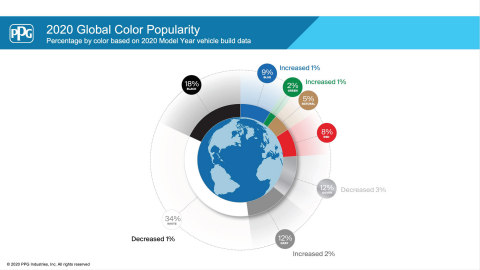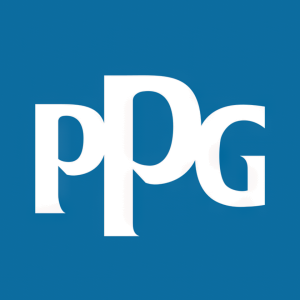Blue Automobiles to Lift COVID Blues? PPG 2020 Automotive Color Report Shows Blue Hues Maintaining Pre-Pandemic Growth
PPG (NYSE:PPG) has published its 2020 automotive color popularity report, revealing that blue hues have risen to 9% of global share, up from 8% in 2019. The increase is attributed to consumer preferences influenced by the COVID-19 pandemic, with blue becoming more prominent in vehicles, particularly in Asia-Pacific, where it saw a 1% rise. While white remains the most popular color at 34%, its share decreased by 1%. The report forecasts that blue will continue to evolve into vibrant and desaturated shades, while overall, natural tones are gaining traction, reflecting changing consumer attitudes.
- Blue colors increased to 9% of global automotive color share, up from 8% in 2019.
- Blue gained popularity in Asia-Pacific markets, driving overall growth.
- Forecasts predict further evolution of blue into more vibrant tones and shades.
- White automotive color preference declined by 1% to 34% in 2020.
- Sales of blue minivans fell by 6% in China.
Insights
Analyzing...
PPG (NYSE:PPG) today released its 2020 automotive color popularity report, which shows blue hues continuing to increase in popularity. The optimistic color climbed to

PPG released its 2020 automotive color popularity report, showing blue hues continuing to increase in popularity. The optimistic color climbed to
The trend reinforces PPG’s 2019 automotive color forecast, which anticipated that sales of blue automobiles would increase over the next four years. PPG experts believe the global COVID-19 pandemic is likely to further fuel global preference for the color.
“COVID-19 has consumers focusing on their desires and priorities,” said Misty Yeomans, PPG color styling manager, Americas. “Blue is an optimistic, comforting color that conveys trust, dependability, confidence, healing and hope. It’s also associated with nature, cleanliness and future-forward technology.”
While blue held steady in most regions, it increased
In Europe, blue occupies
As the movement toward blue continues, Yeomans expects the color to emerge in more vivid or desaturated shades, deep-sea luxury tones and hues with a slight turquoise influence.
“Digital-inspired aqua-blues combine versatility with a sense of youthfulness and a fresh spirit,” said Yeomans. “The emergence of the electric vehicle (EV) market also will drive growth in vibrant tones and interesting effects, such as color-shifting colors. We’re also seeing blue used more extensively in trim lines, logos and other accessorizing applications.”
Consumer demand and the need to accommodate autonomous driving technologies helped white remain the world’s most popular automobile color. While preference for white tones fell
“White colors also reflect consumers’ desire for refined simplicity and versatility in turbulent times,” Yeomans said. “In addition to the pearl and metallic whites that are already widely popular, we anticipate a new dimension of white stylings in the automotive market that create a warm, sophisticated feel, such as creamy shades of ivory or bone-colored tints and ceramic effects. White colors are also highly compatible with emerging radar and LiDAR technologies that enable self-driving vehicles.”
Together, green, blue and natural shades accounted for
“Red is consistent and an important color space in the automotive market, holding steady at
Holding steady at
“Effects and finishes that incorporate black tones allow for artistic reveals in the way color shifts, highlighting hidden undertones and adding a dramatic flair to the possibilities provided by the new pigments and finishes being developed within this color family,” Yeomans said.
Globally, a slight decrease in the popularity of silver was balanced by a corresponding increase in preferences for gray. Silver tones dropped from
PPG forecasts that gray will remain a popular core color for automotive stylists moving forward, driven by the resurgence of concrete and stone materials and the ongoing appeal of ceramic and metal tones. The gray palette will shift toward warmer hues with brown influences, while blue-inflected grays will retain their fashionability.
The influence from nature will be apparent in silver stylings moving forward as well, according to PPG experts. Warmer and more organic tones will further reflect current consumer tastes, while also aligning with the highly compatible nature of very light tones, including whites, with new radar and LiDAR technologies.
Because PPG coats more surfaces than any other company and its paint colors are sold in more than 70 countries, developing color trends is a global, cross-cultural effort. Fact-based collaboration among more than 20 PPG color experts generates the company’s color trends and consumer preferences, resulting in a unified voice on color direction.
PPG color stylists around the world specialize in industries that include consumer electronics, architectural, automotive and aerospace. These experts study consumer mindsets, building material trends, wellness preferences and more to select a curated color forecast that resonates and is reflective of current consumer attitudes and spans cultures, regions and markets.
EDITOR’S NOTE: For more information on PPG’s automotive color popularity report, visit news.ppg.com/2020automotivecolor. For more information on PPG’s architectural coatings color trends, visit news.ppg.com/2021colortrends.
PPG: WE PROTECT AND BEAUTIFY THE WORLD™
At PPG (NYSE:PPG), we work every day to develop and deliver the paints, coatings and materials that our customers have trusted for more than 135 years. Through dedication and creativity, we solve our customers’ biggest challenges, collaborating closely to find the right path forward. With headquarters in Pittsburgh, we operate and innovate in more than 70 countries and reported net sales of
We protect and beautify the world is a trademark and the PPG Logo is a registered trademark of PPG Industries Ohio, Inc.
CATEGORY Automotive OEM Coatings
View source version on businesswire.com: https://www.businesswire.com/news/home/20210209005301/en/







